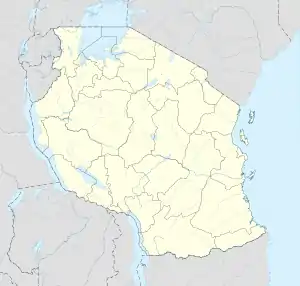Chogo
Chogo (deutsch auch Tschogo) ist eine Siedlung im Distrikt Handeni in der Region Tanga im Nordosten Tansanias, die von der tansanischen Regierung und dem UNHCR für rund 3000 somalische-Bantu-Flüchtlinge eingerichtet wurde. Sie liegt innerhalb des Gebietes der Ethnie der Zigula.[1]
Die Flüchtlinge stammen größtenteils von Sklaven ab, die im 19. Jahrhundert durch den ostafrikanischen Sklavenhandel aus diesem Gebiet nach Somalia gebracht worden waren. Viele sprechen bis heute die Zigula-Sprache und haben Traditionen der Zigula beibehalten. In Somalia waren die Sklaven bzw. ihre Nachkommen nach ihrer Flucht oder Freilassung eine diskriminierte Minderheit geblieben.[2]
Nach Ausbruch des somalischen Bürgerkrieges waren sie Anfang der 1990er Jahre auf dem Seeweg nach Mombasa (Kenia) und von dort weiter in die Tanga-Region geflohen. Dort wurden sie zunächst in der Flüchtlingssiedlung Camp Mkuyu bei Handeni untergebracht.
2003 konnten die etwa 3000 Flüchtlinge in Chogo einziehen, wo ihnen Infrastrukturen und Land für eine Existenz als Kleinbauern zur Verfügung gestellt wurden.[3]
Chogo ist mit einer Gesundheitsstation, Schulen, einem Markt und einer Polizeistation ausgestattet. Diese Einrichtungen der Siedlung sollen auch den rund 1000 Einheimischen zugutekommen. Der Bau von Chogo kostete etwa zwei Mio. US-Dollar. Die Lebensumstände sind jedoch, nachdem die UNHCR das Lager nach drei Jahren an die lokalen Behörden übergeben hat, besorgniserregend: Die Lagerinsassen müssen beispielsweise den Klinikaufenthalt und Medikamente selbst bezahlen, daher ging der Gesundheitsservice inzwischen dramatisch zurück. Es bestehen auch kaum Erwerbsmöglichkeiten, daher nimmt die Kriminalität zu.[4]
Den Flüchtlingen wurde gestattet, die tansanische Staatsbürgerschaft zu beantragen, was bislang Hunderte mit Erfolg taten. So erhielten am Weltflüchtlingstag 2007 550 von ihnen die entsprechenden Dokumente[5], 2008 erhielten 202 zu diesem Anlass die Staatsbürgerschaft[6].
Weblinks
Einzelnachweise
- Z. Tunze, E. Rowley et al: Patterns of transactional sex and condom use indicate high risk of HIV transmission for refugee women. (PDF; 7,2 MB) (Nicht mehr online verfügbar.) UNHCR, 2010, S. 1, archiviert vom Original am 28. Dezember 2010; abgerufen am 26. März 2011 (englisch, Prospekt mit Lagekarte). Info: Der Archivlink wurde automatisch eingesetzt und noch nicht geprüft. Bitte prüfe Original- und Archivlink gemäß Anleitung und entferne dann diesen Hinweis.
- History and Discrimination of the Bantus. (Nicht mehr online verfügbar.) The Original Somali Bantu Wazigua Community Organization of Central New York, 2011, archiviert vom Original am 27. August 2013; abgerufen am 26. März 2011 (englisch). Info: Der Archivlink wurde automatisch eingesetzt und noch nicht geprüft. Bitte prüfe Original- und Archivlink gemäß Anleitung und entferne dann diesen Hinweis.
- About Refugees Services Department. United Republic of Tanzania, Ministry of Home Affaires, Refugee Services Department, 2011, abgerufen am 26. März 2011 (englisch): „MKUYU CAMP ... In 2003 these refugees were shifted from Mkuyu to Chogo in the same District. The shift was inevitable due to the limited space in Mkuyu, and as the Tanzanian Government had the plan of offering them citizenship as a durable solution for their predicaments, it was thus appropriate to settle them at a place where there is ample space for allocating them big pieces of land as a way of making them self- sufficient. The Government also considered the fact that these Zigua speaking Somalis can easily integrate with their fellow Tanzanian Ziguas who reside within the Handeni District. There are currently about 1431 Somali refugees at Chogo settlement, and 1423 refugees have already been naturalized after being given Tanzanian citizenship, while others have already applied for it. A considerable number of them are self sufficient, therefore, only a few are still depending on relief food and items. UNHCR is on the last stage of phasing out its aid to the settlement. The camp was re-located and replaced by the current Chogo settlement.“
- Heather's Blog: Heather in Tanzania. 2008, abgerufen am 26. März 2011 (englisch, Bericht einer kanadischen Studentin (Sozialarbeiterin) von ihrem Einsatz im Lager Chogo): „The clinic which we thought was available to all the refugees is in fact inaccessible to most. Why can’t the refugees use the clinic that was built for them? Well ever since UNHCR pulled out of the camp 3 years ago the refugees have had to pay out of their own pockets for the services provided at the clinic. But there is no economy in the camp. The refugees have little way of making money, and they are not permitted to leave the camp for long enough periods to actually find work and make some money elsewhere. Those that try are picked up by immigration and jailed. So, most refugees don’t visit the clinic when they are ill. Those that can afford the cost use the clinic at times but the services that the clinic offers are limited and for most major illnesses the patient must be sent to a larger hospital, this too also costs a great deal. Barely anyone in the camp is able to afford transport. As such, we have been told that many people who become ill in Chogo never get the medical attention they need and often they die because they can’t afford the ~$40 US fuel fare to get to the hospital 1 hour away. It is a really sad situation.“
- UNHCR: World Refugee Day (WRD) 2007 National Activities: Tanzania
- UNHCR: Millions mark World Refugee Day with theme of "Protection"
